Thursday Nov 27, 2025
Thursday Nov 27, 2025
Thursday, 10 May 2018 00:00 - - {{hitsCtrl.values.hits}}
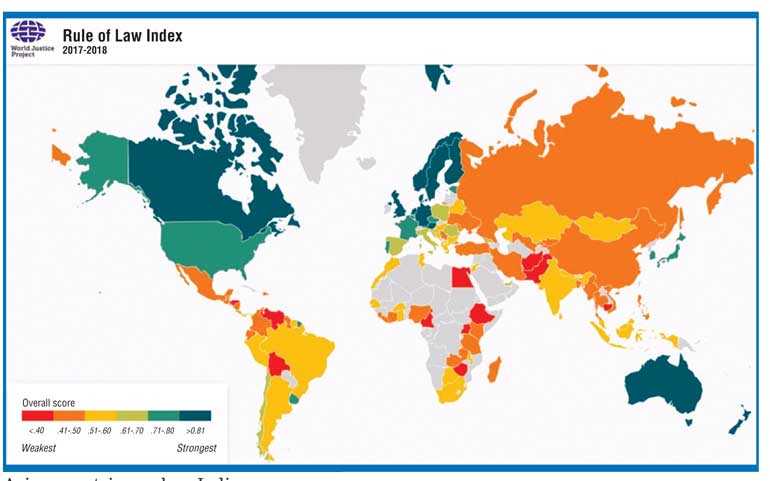
Sri Lanka became independent in February 1948. Looking back at the socioeconomic backdrop of Sri Lanka before 1948 and after, it is clear that significant changes have taken place periodically. Let us revisit these crucial times of our economy and look at Sri Lanka from the eyes of Lee Kuan Yew, the great visionary who guided Singapore into the economic superpower it is today.
Compared to other Asian countries, Sri Lanka has an abundance of historical economic statistics, particularly since 1802 when Ceylon came under the British control. For taxation purposes, Ceylon’s British administrators intensified and improved the collection of statistical data throughout the 19th and early-20th centuries.
Ceylon became a major producer of agricultural exports, such as coffee, tea, rubber, coconut and the data on agricultural export production are particularly extensive. Consequently, when the country received a degree of self-government in 1931 and independence in 1948, Ceylon’s official agencies generated a good amount of economic statistics of reasonable quality compared to other less-developed countries in Asia.
M.R.P. Salgado’s 1960 Ph.D. thesis offered historical national accounts data from 1920-1938. The book offers a detailed quantitative analysis of fours sectors of Ceylon’s economy (public and private sectors, households and the rest of the world), as well as their interactions, during 1920-1938. Salgado’s findings can be summarised as follows. 
Agriculture generated on average 29% of GDP, indicating that structural change seemed well-advanced in Ceylon. Average per capita GDP was the equivalent of $ 57, peaking in 1926 at $ 80 and reaching an all-time low in 1932 at $ 33, less than 10% of GDP per capita in the US. The ratio of exports and GDP was on average 34%, indicative of an open economy, dependent on export earnings.
Ceylon had a significant commodity trade surplus, which largely underpinned the disbursement of private sector profits to investors located overseas. On average, net overseas payments were 7% of GDP, with a maximum of 12% in 1925. The average ratio of public expenditure and GDP was just 14% and the ratio of gross fixed capital formation and GDP was just 11%, both indicating limitations to the roles of public policy and investment in spurring economic growth.
During the year 1950-1952 we had foreign reserves to feed the country (imports) for 18 months. The present Government recently announced we have reserves for four months. The chart will give you an idea the worst in 1975 (one month) to 2015 (three months). Presently, in foreign exchange reserves we are at the 83rd position with $ 7,669 million and we can see some of the Asian countries such as India $ 420,366 million, Singapore $ 376,285 million and Thailand $ 216,600 million at the 8th, 11th and 12th positions respectively.
Lee Kuan Yew on Sri Lanka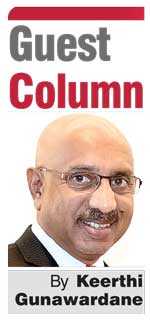
One of the great leaders in Asia, Prime Minister Lee Kuan Yew wrote in his memoirs, talking of Sri Lanka, this is what Lee Kuan Yew says:
“We have got to live with the consequences of our actions and we are responsible for our own people and we take the right decisions for them. You look at the old Philippines. The old Ceylon. The old East Pakistan and several others. I have been to these countries and places. When I went to Colombo for the first time in 1956 it was a better city than Singapore because Singapore had three and a half years of Japanese occupation and Colombo was the centre or HQ of Mountbatten’s Southeast Asia command. They had sterling reserves. They had two universities. Before the war, a thick layer of educated talent so if you believe what American liberals or British liberals used to say, then it ought to have flourished.”
The memoirs of Lee Kuan Yew, widely-acclaimed as the architect of modern Singapore and titled ‘From Third World to First – The Singapore Story: 1965-2000’ published in 2000 by Times Media Ltd. and The Straits Times Press. In some pages he speak about the memoirs and his impression about Sri Lanka.
Lee visited Sri Lanka for the first time in 1956. Staying at the Galle Face Hotel, he had been impressed by our public buildings, many with stone facing. He emphasises that due to Mountbatten basing his Southeast Asia command in Kandy, Ceylon as we then called it had more resources and better infrastructure than Singapore.
According to Lee, the start of the unravelling of Sri Lanka was in 1956 with Sinhala being made the national language and other moves to make Ceylon a more of a Sinhalese Buddhist country. He says that the leaders of that day did not seem troubled that Jaffna Tamils and other minorities would be at a disadvantage now that Sinhala was the national language, or by the unease of the Hindu Tamils, the Muslim Moors and the Christian Burghers regarding the elevated status of Buddhism as the national religion.
Lee recalls the claim by Felix Dias Bandaraniake who he names as Mrs. Bandaranaike’s eminence person for international affairs, that good fortune of geography and history had blessed Ceylon with peace and security so that only 2.5% of Ceylon’s budget was spent on defence; and then questions the irony of this claim when in the late 1980s more than half of the budget went into arms and the defence forces to crush the Jaffna Tamil rebellion. According to Lee, when Ceylon gained independence in 1948, it was the classic model of gradual evolution to independence. Ceylon was Britain’s model Commonwealth country. He says, after the war, Ceylon was a good middle size country with fewer than 10 million people. It had a relatively good standard of education with two universities of high quality in Colombo and Kandy teaching in English, a civil service largely of locals, and experience in representative government starting with city council elections in the 1930s.
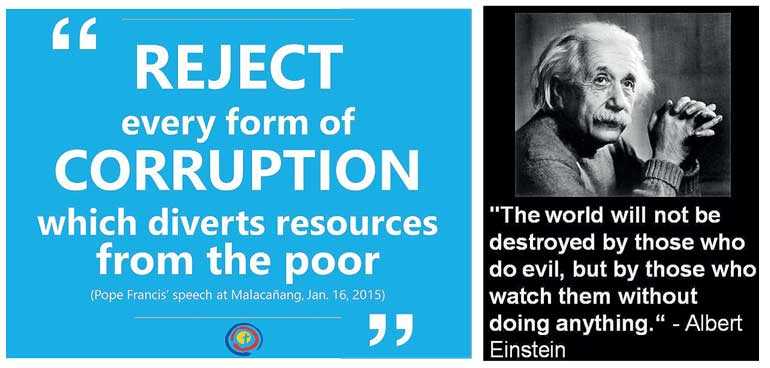
Impressed by Sri Lanka
Lee was so impressed by Sri Lanka. This is the very reason he wanted to develop Singapore like Ceylon. The simple example during the old days in the Asian region most of the teachers are from Sri Lanka. Singapore, Malaysia, Thailand, Maldives still recollect the good memories of the excellent Sri Lankan teachers taught them. I have my personal experience in this.
The Managing Director of one of the top business forms manufactures in Singapore introduced me to his father who was a construction company owner at the start of his life during the time of Lee Kuan Yew. When I was introduced to him he was very happy to see his son was doing business with a Sri Lankan. He said during his time all the good teachers came to Singapore from Sri Lanka. He said, “All good lawyers during that time came from Sri Lanka to fight our tough cases in Singapore.” I met him during the time we had fights with the Tamil Tigers in Sri Lanka. He told me he cannot believe the setup in Sri Lanka today, the Sri Lankans known to him were such nice, peaceful, humble and knowledgeable people in this whole region.
In Lee’s own words: “Alas, it did not work out. During my visits over the years I watched a promising country go to waste.” As he states, one-man-one-vote did not solve the basic problem. The majority of eight million Sinhalese could always outvote the two million Jaffna Tamils who had been disadvantaged by the switch from English to Sinhala as the official language.
It was so sad that our leaders could not realise the ground reality whereas another Asian leader in the region understood the local situation better than the politicians we had in our own country. The biggest mistakes we made in this country were making Sinhala the national language and Sinhala Buddhists the priority just to attract the majority votes to one political party. This move separated the country and finally had to face a 30-year-long war. In addition paid the biggest price by the country and lost lots of lives and opportunities. After such a bitter experience for all of us, still we see different political parties try the same to come to power.
During the old days we were one of the best countries in Asia, only second to Japan with a higher level of education. During that time not only our universities but all the colleges and even the central colleges produced the best of the administrators with the highest quality who were very good in Sinhala, English and Tamil too.
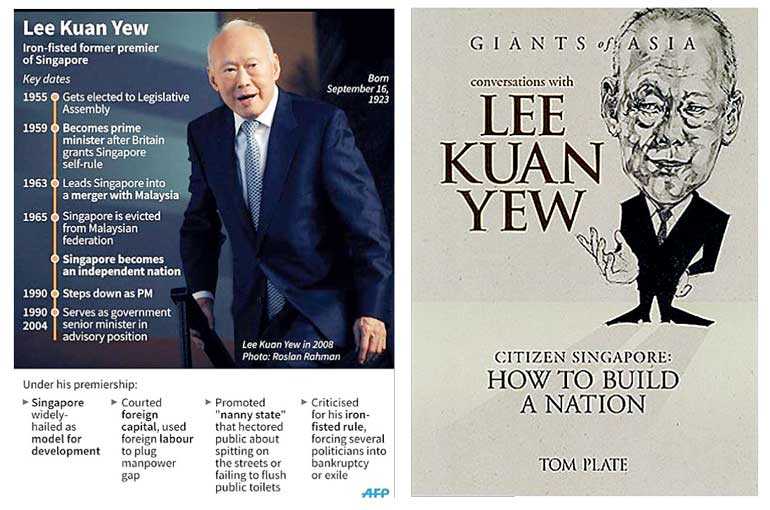
Rule of law
On another visit to Ceylon in 1966 to meet Prime Minister Dudley Senanayake, Lee recalls playing golf with our then Prime Minister on the Royal Colombo Golf Course. Prime Minister Senanayake had apologised for the encroaching squatter huts and the goats and cows on the fairways. According to Lee, our Prime Minister had said that it was inevitable with democracy and elections and that he could not justify keeping open spaces in the centre of the city.
Lee pointed out the importance of the democracy as well as the law and order in the country. He stressed the point why is the rule of law important for a country.
Rule of law establishes a disciplined society in a country. Democracy and freedom will let people do what they like. Law and order bring the guidelines on how it can be done. This should be common for all the people in the country from top to bottom. If the top is disciplined the same will trickle down to the bottom.
If you see the Sri Lankan roads today, all talk about the indiscipline of the three-wheeler drivers, private bus drivers and motorcycle riders, but the politicians and forces do more reckless and indiscipline driving on the road in this country. In Singapore if anyone does a mistake it is the same punishment for anyone in society. It is evident any disciplined country in the world will have the best of road manners. This is the starting point of basic law and order in any country. If we go further, good principals make good students. Good priests make good temples, churches, mosques and finally disciplined people to society.
Drop in quality and standards
The also-rans in the Transparency International Corruption Perceptions Index of 2017 – It should be noted that this report is synthesised from data from 13 different surveys that look at factors such as enforcement of anti-corruption laws, access to information and conflicts of interest by officialdom, and not all of the world’s countries are listed in the report – there is not enough data available to reliably assess them. There are more than 200 sovereign nations in the world, and the 2017 CPI only ranks 180 of them. Hence a country’s rank can change as new countries enter the index or others drop out. (Credit: Transparency International)
During this visit Lee Kuan Yew decided to travel to Nuwara Eliya by train on a special carriage. When we was travelling on the way he was served food.
“The crab was badly contaminated and stank. I went immediately to the toilet and spewed it all out. This saved me,” said by Lee.
In Nuwara Eliya, he had stayed in the then dilapidated former British Governor’s hill residence, ‘The Lodge’. The golf course in Nuwara Eliya, Lee recalls, was also encroached upon by huts, goats and cows. According to him the tea plantations were in a deplorable condition and the locals who had been promoted were not as good supervisors as their British predecessors. The coconut plantations had also suffered. As an old Sinhalese person had told him that this was the price people had to pay to learn how to run the country.
This shows that we have never tried to maintain the quality set by the British after independence and started deteriorating day by day. Lee’s statement was very evident that we have neglected in maintaining the quality in many places. We have not even set standards to maintain the level which was prevailing at that time. Instead of continuous improvement we came down from the place where we were.
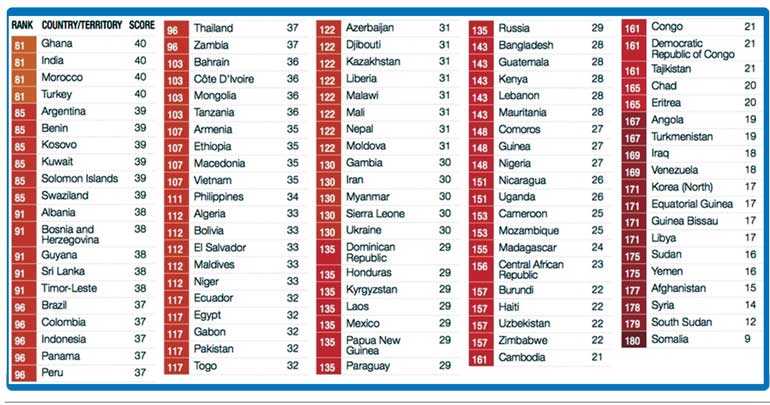
National Carrier
He then discusses the period of President J. R. Jayewardene from 1977. He says, like some of his predecessors, Jayewardene was born a Christian, converted to Buddhism and embraced nativism to identify himself with the people. Jayewardene wanted to move away from Sri Lanka’s socialist policies that had bankrupted it. Lee, impressed by Jayewardene’s practical approach, had been persuaded to once again visit Sri Lanka in April 1978.
President J.R. Jayewardene expected Lee’s support to launch a new airline in Sri Lanka. Lee however had not seen the urgent need for an airline project which Jayewardene believed was a symbol of progress. Lee had advised that an airline should not be a priority because it required too many talented and good administrators to get it off the ground when they were more needed for irrigation, agriculture, housing, industrial promotion and development and so many other projects.
An airline was a glamour project, not of great value for a developing Sri Lanka. But due to President Jayewardene’s insistence, Singapore had helped launch it in six months. Lee states that it was the decision of the former Singapore Airlines-employed Sri Lankan pilot who was at the time the Chairman of the new airline to buy two second-hand aircraft against their advice that led them to withdraw their assistance and support. Lee states, faced with a five-fold expansion of capacity, negative cash flow, lack of trained staff, unreliable services and insufficient passengers, it was bound to fail. And it did.
In the original days Ratmalana was one of the main airports in Asia. When Lee came to Sri Lanka in the year 1966 after a meeting in the United Kingdom, he landed at the Ratmalana Airport. This means during the 1960s Sri Lanka was one of the aviation hubs in Asia. Air Ceylon was founded in 1947 as the flag carrier airline of Ceylon (known as Ceylon until 1972). The airline discontinued flights to Europe in early 1978 and finally ceased all local services on 31 August 1979, when it was replaced by Air Lanka.
Singapore Airlines
Singapore Airlines began with the incorporation of Malayan Airways Ltd. (MAL). Originally the flights were limited from Singapore to Kuala Lumpur only. After Singapore separated from Malaysia they saw the opportunity of developing Singapore as an aviation and marine hub. They start aggressive work towards making Singapore a regional hub in Asia. After such an attempt Sri Lanka trying to build a fresh airline was not something Lee would have loved to support.
Singapore was very successful just after starting Singapore Airlines and they were buying many large aircraft and improved the airport and the airline services very fast. However Singapore had serious issues with Singapore Airline pilots and as a country Singapore started losing both credibility and money. As the final solution Lee Kuan Yew undertook to talk to the pilots. After getting them back to work he addressed the public and explained how he managed the Singapore Airline pilots to get back to work.
This is how he explained in his own words: “I can tell you when I met the SI pilots, I didn’t meet them on TV. I met them face to face, five feet across the table so they can see me and see whether I am still vigorous, able to campaign and take them on, whether it is worth taking me on. I offer them two choices, either you argue or stop this intimidation which is what it was, bringing SIA right down, disrupting services, ruining its reputation, millions of dollars’ worth of advertisements and sales, ruin within a matter of two weeks. I gave them a choice, continue this and I will by every means at my disposal teach you and get the people of Singapore to help me teach you a lesson you won’t forget and I am prepared to start all over again or stop it. Get back to work, restore discipline and argue your case. It took them 65 minutes and they decided OK it isn’t worth the fight. Why? Because they know they will lose. They know that I am prepared to ground the airline and they know that I can get the airline going again without them and there is no mistake about this. Whoever governs Singapore must have that iron in him or give it up. This is not a game of cards. This is your life and mine. I spend my whole lifetime building this and as long as I am in charge, nobody is going to knock it down.”
This was a good example from Singapore, where there is an expected service from a group of professionals and they are not supposed to be using democracy to inconvenience clients or damage the reputation of the country. Professionals are supposed to deliver a service uninterrupted to the community while maintaining ethics and social responsibility. This is one of the good case studies for Sri Lanka to understand democracy, good governance, ethics and uninterrupted service to the client.
Right now the bus drivers in Japan have gone on strike in an unusual way. Instead of forming a protest line, they’ve draped blankets over the fare machines and are giving free rides to everyone. This is an interesting tactic. If they had refused to drive the buses, the company’s management could tell the public that the drivers only cared about themselves and not the passengers who depend on the buses. Instead, the drivers are doing everything they usually do, except collect money.
I am sure a fast solution will come from the bus-owning companies to the drivers. If this continues bus owners will lose a lot of money which can be utilised for a pay increase of the bus drivers. This is also another good case study for our Sri Lankan professionals to follow. As we have seen in Sri Lanka, the protests will make hardships to the general public or the user of the specific professional service in many ways.
Mistakes made
The greatest mistake Jayewardene made, according to Lee, was over the distribution of reclaimed land in the dry zone. With foreign aid, the ancient irrigation scheme based on tanks which could store water brought from the wet zone was revived but unfortunately the reclaimed land was given to the Sinhalese, not the Tamils who had historically been the farmers of this dry zone. Lee denotes, this as another cause of today’s ethnic problem.
Lee then criticises the move by President Premadasa who he calls a Sinhalese chauvinist to get rid of the Indian troops from the country. It was not sensible at that time. Lee says that he tried on numerous occasions to convince President Premadasa that this conflict could not be solved by force of arms and that a political solution was the only way, one considered fair by Jaffna Tamils and the rest of the world.
Lee ends his note on Sri Lanka by saying: “It is sad that the country whose ancient name Serendip has given the English language the word ‘serendipity’ is now the epitome of conflict, pain, sorrow and hopelessness.”
These are a few things a single person has seen over the years after the independence of our country. Who is responsible for these mistakes? I think as a country every single person is responsible for the mistakes we are making. Today we are in the messiest situation, with even the President’s Chief of Staff getting caught taking a bribe from a foreign direct investor. Under these circumstances, can any of the good investors come to Sri Lanka?
There is no doubt our ratings are coming down compared to a few years back. From the year 2010 to 2012, we managed to improve our position from 97 to 79 globally and in the year 2017 we are back in the 91st position we were ranked in 17 years back (2010). We all were expecting under the Yahapalana regime at least for bribery and corruption to come down for the benefit of our country. It is so sad to see there is no progress and it is clear from the chart where the Sri Lanka stands.
When we look at the USD and Sri Lanka Rupee since independence, the Sri Lanka Rupee starts depreciating largely with the USD. As an example in the year 1950, $ 1 = SLR 4.76 and today it has gone to almost Rs. 160. This shows that none of the governments which came into power since independence have managed the economy well. It is high time for us to think about the country and start immediate corrective steps towards becoming a progressive economy. We need patriotic leaders to lead us who value economic progress, discipline and the wellbeing of the citizens, who can stop bribery and corruption and move the country forward.
Risks and challenges
According to the World Bank Economic Outlook, the risks and challenges they describe are as follows:
Political uncertainty is the key risk to an otherwise-favourable medium-term outlook. External risks include lower growth in key countries that generate foreign exchange inflows to Sri Lanka. Steeper than expected global financial conditions would increase the cost of debt. It will also make rolling over the Eurobonds maturing from 2019 more difficult. Faster-than-expected rises in commodity prices would increase pressure on the balance of payments and make domestic fuel and electricity price reforms more difficult.
On the fiscal and debt management front, risks include the delay in implementing revenue and liability management measures, and slower than expected improvement in tax administration. The increasing occurrence and impact of natural disasters could adversely impact growth, the fiscal budget, the external sector and poverty reduction. It is obvious we are on a do or die situation, needs more attention to stop bribery, corruption and move the country forward.
As citizens of Sri Lanka, can we allow the power struggle between the political parties, corruption, mismanagement of the economy, and mismanagement of State institutions to go on like this? Do we have any advantage of having such a large Cabinet in such a small country? Do we need such a large number of members at provincial level to improve our services? The numbers against the services, have we seen any improvement for the general public in Sri Lanka?
(The writer is an Economics Hons Graduate from the Sri Jayawardenepura University, Immediate Past President of the International Chamber of Commerce and the Vice President of the Federation of Chamber of Commerce and Industries Sri Lanka.)
